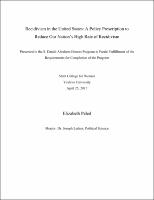Please use this identifier to cite or link to this item:
https://hdl.handle.net/20.500.12202/4078Full metadata record
| DC Field | Value | Language |
|---|---|---|
| dc.contributor.author | Peled, Elizabeth | - |
| dc.date.accessioned | 2018-11-05T21:42:08Z | - |
| dc.date.available | 2018-11-05T21:42:08Z | - |
| dc.date.issued | 2017-04 | - |
| dc.identifier.uri | https://hdl.handle.net/20.500.12202/4078 | - |
| dc.identifier.uri | https://ezproxy.yu.edu/login?url=https://repository.yu.edu/handle/20.500.12202/4078 | |
| dc.description | The file is restricted for YU community access only. | - |
| dc.description.abstract | When thirteen-year-old Ian Manuel entered Florida’s Apalachee Correctional Institution in 1991, he was never supposed to leave. Convicted of armed robbery and attempted murder, Manuel was sentenced to life in prison without the chance of parole. However, he was released in 2016 after the Supreme Court ruled that sentencing a minor to life without parole for an offense less than murder is unconstitutional. Manuel spent most of his time in prison in solitary confinement for bad behavior. His life could have spiraled out of control and effectively ended the day he entered the correctional facility. But Manuel found a savior in his victim, Debbie Baigrie. Baigrie forgave her shooter, encouraged him to get his GED while imprisoned, and wrote him letters throughout his sentence. Manuel credits Baigrie’s mentorship for his new life in Montgomery Alabama, where he helps former prisoners adjust to society post-release. 1 Manuel’s post-release success is not common for ex-inmates in the United States, where our prison population is expanding, corrections costs are rising, and our rate of recidivism is one of the highest in the world. In 2012 alone, $39 billion of American taxpayer money from just forty states was spent on prisons, which is equivalent to Germany’s entire military budget. 2 The U.S. currently spends $80 billion annually on incarceration, and eleven of its states spend more on prisons than on public universities. | en_US |
| dc.description.sponsorship | S. Daniel Abraham Honors Program | en_US |
| dc.language.iso | en_US | en_US |
| dc.publisher | Stern College for Women | en_US |
| dc.rights | Attribution-NonCommercial-NoDerivs 3.0 United States | * |
| dc.rights.uri | http://creativecommons.org/licenses/by-nc-nd/3.0/us/ | * |
| dc.subject | Recidivism --United States. | en_US |
| dc.subject | Prisoners --United States. | en_US |
| dc.subject | Criminals --Rehabilitation --United States. | en_US |
| dc.subject | Recidivism --Great Britain. | en_US |
| dc.subject | Recidivism --Germany. | en_US |
| dc.subject | Recidivism --Scandinavia. | en_US |
| dc.title | Recidivism in the United States: A Policy Prescription to Reduce Our Nation’s High Rate of Recidivism | en_US |
| dc.type | Thesis | en_US |
| Appears in Collections: | S. Daniel Abraham Honors Student Theses | |
Files in This Item:
| File | Description | Size | Format | |
|---|---|---|---|---|
| Elizabeth-Peled.pdf Restricted Access | 315.45 kB | Adobe PDF |  View/Open |
This item is licensed under a Creative Commons License

